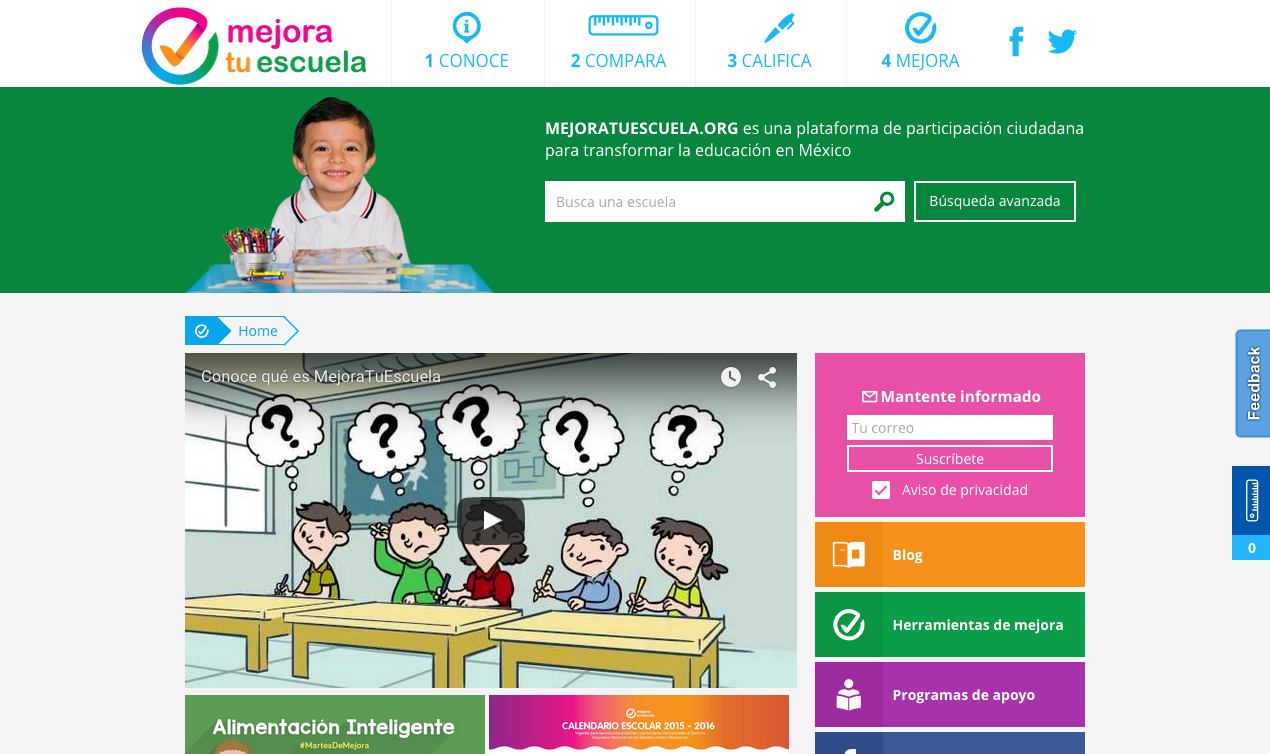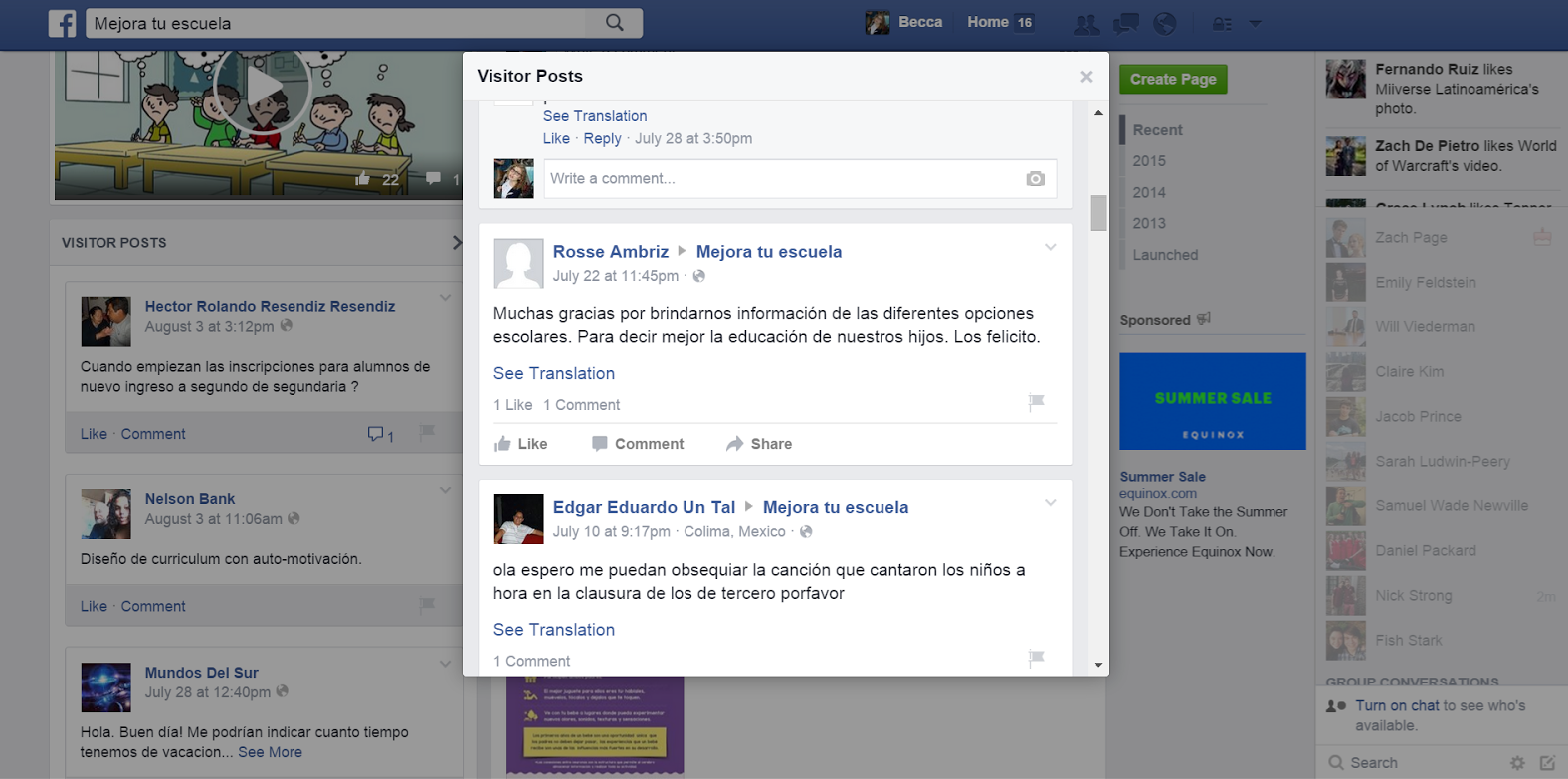The Global Impact of Open Data
Mexico’s Mejora Tu Escuela
Empowering Citizens to Make Data-Driven Decisions About Education
by Andrew Young and Stefaan Verhulst*
Reference
2Villagran, Lauren. “Test the teacher? Educators balk at Mexico’s reforms.” The Christian Science Monitor. March 1, 2013. http://www.csmonitor.com/World/Americas/2013/0301/Test-the-teacher-Educators-balk-at-Mexico-s-reforms
3Villagran, Lauren. “Test the teacher? Educators balk at Mexico’s reforms.” The Christian Science Monitor. March 1, 2013. http://www.csmonitor.com/World/Americas/2013/0301/Test-the-teacher-Educators-balk-at-Mexico-s-reforms
4Villagran, Lauren. “Test the teacher? Educators balk at Mexico’s reforms.” The Christian Science Monitor. March 1, 2013. http://www.csmonitor.com/World/Americas/2013/0301/Test-the-teacher-Educators-balk-at-Mexico-s-reforms
5Cave, Damien. “Billboard Drives Home Extent of Corruption as Schools Suffer.” The New York Times. September 1, 2014. http://www.nytimes.com/2014/09/02/world/americas/billboard-drives-home-extent-of-corruption-as-schools-suffer.html.
6Cave, Damien. “Billboard Drives Home Extent of Corruption as Schools Suffer.” The New York Times. September 1, 2014. http://www.nytimes.com/2014/09/02/world/americas/billboard-drives-home-extent-of-corruption-as-schools-suffer.html
7Transparency International, ‘Corruption in the Education Sector’, Working Paper no. 04/2009 (Berlin: TI, 2009), p. 6.
9Starks, Gavin. “Why open data should be central to Fifa reform.” The Guardian. June 12, 2015. http://www.theguardian.com/news/datablog/2015/jun/12/open-data-central-fifa-reform.
10 Zabludovsky, Karla. “Data Dive Finds 100-Year-Old Teachers and Phantom Schools in Mexico.” Newsweek. May 30, 2014. http://www.newsweek.com/data-dive-finds-hundred-year-old-teachers-and-phantom-schools-mexico-252871.
12 Interview with Ania Calderón, Director General of Open Data, Mexican Government. March 9, 2014. https://www.youtube.com/watch?v=j9L5Wo0LEpY.
13Bustos Arellano, Paulina, Ricardo Daniel Alanis Tamez, William Gerry and Codeando Mexico. “Open data in Mexico: how Data Squads jump-started national publishing.” Open Data Institute. https://theodi.org/case-studies/mexico-case-study-using-data-squads-to-jump-start-government-open-data-publishing
14Translated by Google. http://codeandomexico.org/
15GovLab Interview with Oscar Montiel, Codeando México. August 19, 2015.
16GovLab Interview with Oscar Montiel, Codeando México. August 19, 2015.
17GovLab Interview with Rafael García Aceves, Transparencia Mexicana. September 1, 2015.
18Disclosure: Omidyar Network also funded this case study.
20 GovLab Interview with Alexandra Zapata Hojel, Coordinator of Education Projects, IMCO. August 7, 2015.
21GovLab Interview with Alexandra Zapata Hojel, Coordinator of Education Projects, IMCO. August 7, 2015.
23GovLab Interview with Alexandra Zapata Hojel, Coordinator of Education Projects, IMCO. August 7, 2015.
24GovLab Interview with Alexandra Zapata Hojel, Coordinator of Education Projects, IMCO. August 7, 2015.
25Hasan, Munyema. “Mexico: Encouraging Parents’ Engagement in Public Education Reform.” Open Government Partnership. October 2013. http://www.opengovpartnership.org/sites/default/files/Mexico_0.pdf
26GovLab Interview with Alexandra Zapata Hojel, Coordinator of Education Projects, IMCO. August 7, 2015.
27GovLab Interview with Pablo Clark, Analyst, IMCO. August 17, 2015.
30GovLab Interview with Alexandra Zapata Hojel, Coordinator of Education Projects, IMCO. August 7, 2015
31 GovLab Interview with Alexandra Zapata Hojel, Coordinator of Education Projects, IMCO. August 7, 2015.
32 GovLab Interview with Alexandra Zapata Hojel, Coordinator of Education Projects, IMCO. August 7, 2015.
33 GovLab Interview with Alexandra Zapata Hojel, Coordinator of Education Projects, IMCO. August 7, 2015.
34 GovLab Interview with Alexandra Zapata Hojel, Coordinator of Education Projects, IMCO. August 7, 2015.
35 GovLab Interview with Pablo Clark, Analyst, IMCO. August 17, 2015.
36 “IMCO denuncia que SEP manipuló anomalías sobre maestros.” Televisa. May 15, 2014. http://noticieros.televisa.com/mexico/1405/imco-denuncia-sep-desaparecio-anomalias-maestros/.
37 GovLab Interview with Alexandra Zapata Hojel, Coordinator of Education Projects, IMCO. August 7, 2015.
38 GovLab Interview with Rafael García-Aceves, Open Data Project Coordinator, Transparencia Mexicana. September 1, 2015.
39 GovLab Interview with Felipe Estefan, Associate, Investments, Omidyar Network. January 6, 2016.
41 Zabludovsky, Karla. “Data Dive Finds 100-Year-Old Teachers and Phantom Schools in Mexico.” Newsweek. May 30, 2014. http://www.newsweek.com/data-dive-finds-hundred-year-old-teachers-and-phantom-schools-mexico-252871.
42 Zabludovsky, Karla. “Data Dive Finds 100-Year-Old Teachers and Phantom Schools in Mexico.” Newsweek. May 30, 2014. http://www.newsweek.com/data-dive-finds-hundred-year-old-teachers-and-phantom-schools-mexico-252871.
43 Zabludovsky, Karla. “Data Dive Finds 100-Year-Old Teachers and Phantom Schools in Mexico.” Newsweek. May 30, 2014. http://www.newsweek.com/data-dive-finds-hundred-year-old-teachers-and-phantom-schools-mexico-252871.
44 GovLab Interview with Alexandra Zapata Hojel, Coordinator of Education Projects, IMCO. August 7, 2015.
45 Zabludovsky, Karla. “Data Dive Finds 100-Year-Old Teachers and Phantom Schools in Mexico.” Newsweek. May 30, 2014. http://www.newsweek.com/data-dive-finds-hundred-year-old-teachers-and-phantom-schools-mexico-252871.
46 GovLab Interview with Alexandra Zapata Hojel, Coordinator of Education Projects, IMCO. August 7, 2015. August 7, 2015.
47 GovLab Interview with Pablo Clark, Analyst, IMCO. August 17, 2015.
48 GovLab Interview with Alexandra Zapata Hojel, Coordinator of Education Projects, IMCO. August 7, 2015.
49 GovLab Interview with Oscar Montiel, Codeando México. August 19, 2015.
50 GovLab Interview with Alexandra Zapata Hojel, Coordinator of Education Projects, IMCO. August 7, 2015.
51 GovLab Interview with Alexandra Zapata Hojel, Coordinator of Education Projects, IMCO. August 7, 2015.
52 GovLab Interview with Alexandra Zapata Hojel, Coordinator of Education Projects, IMCO. August 7, 2015.
53 GovLab Interview with Alexandra Zapata Hojel, Coordinator of Education Projects, IMCO. August 7, 2015.
54 GovLab Interview with Alexandra Zapata Hojel, Coordinator of Education Projects, IMCO. August 7, 2015.
55 GovLab Interview with Rafael García-Aceves, Open Data Project Coordinator, Transparencia Mexicana. September 1, 2015.
56 GovLab Interview with Felipe Estefan, Associate, Investments, Omidyar Network. August 20, 2015.




